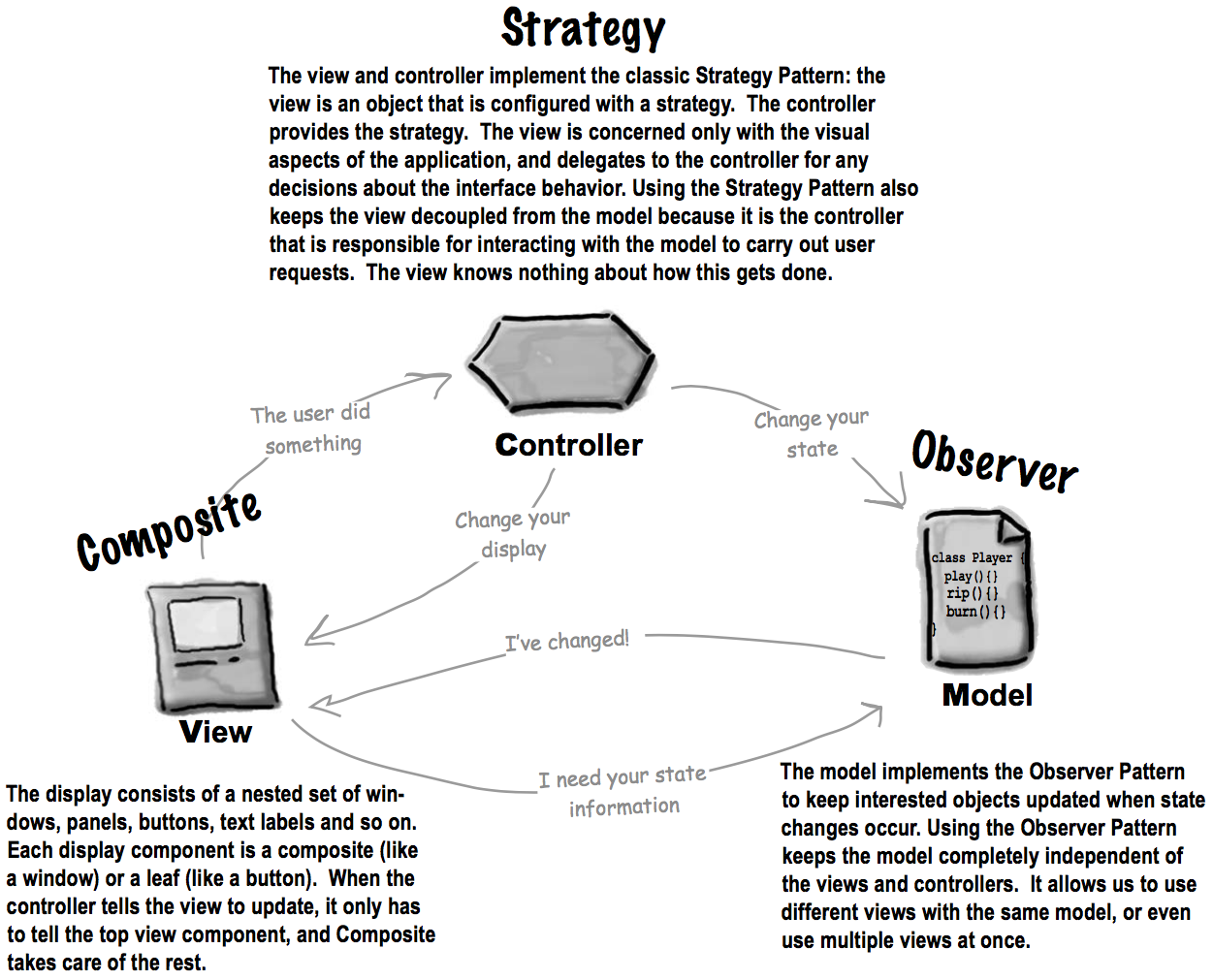设计模式黑板报
高考前教室的后黑板有时会被用来划重点,笔者将本文类比为黑板报,就是为了能够不时回过头来看看这些设计模式,以加深印象。本文包含 《Head First Design Patterns》 一书中提到的所有设计模式。
🔥 策略模式(The Strategy Pattern)
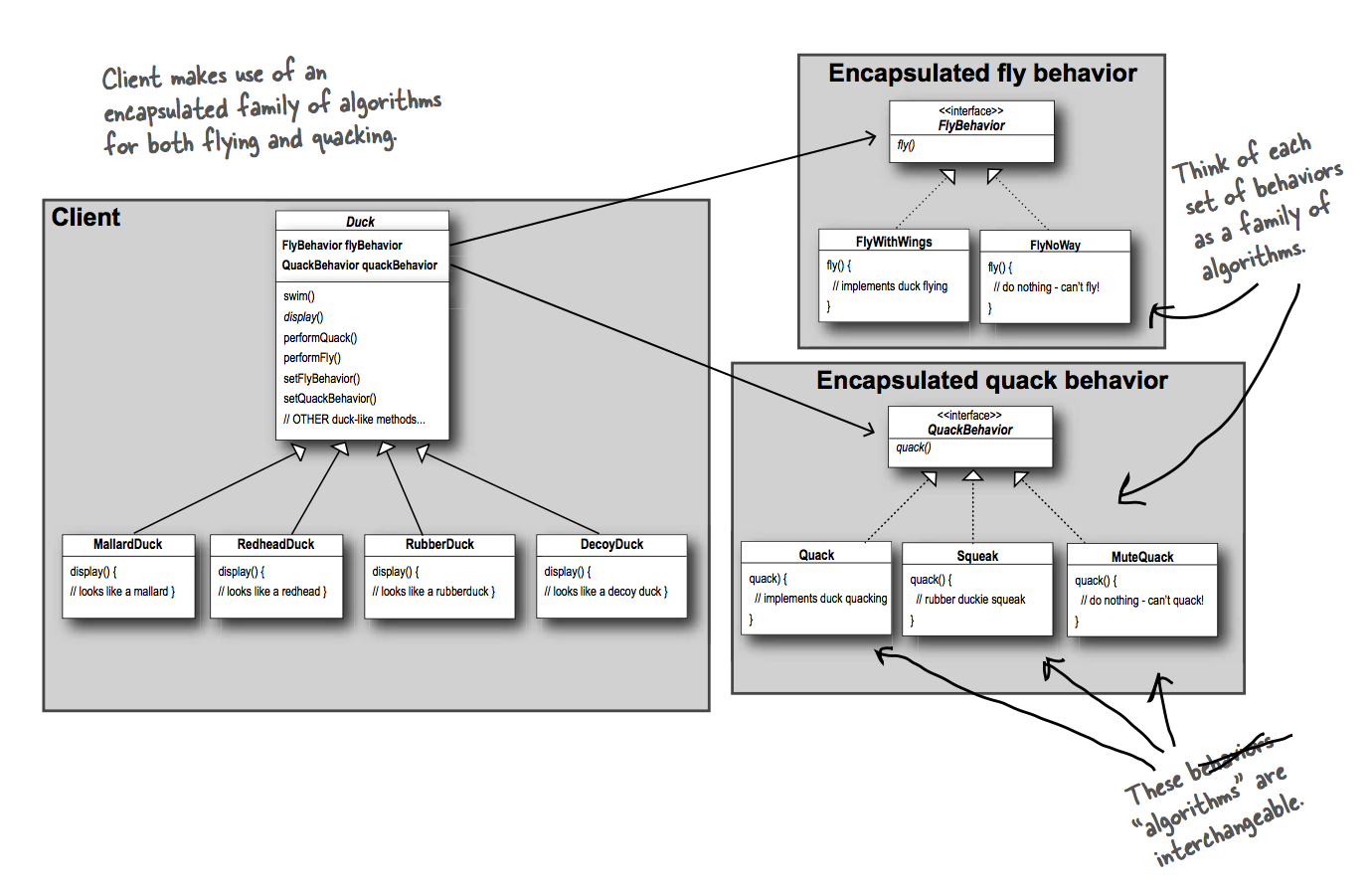
策略模式定义了一组算法,每个算法都用一个类封装,并且之间可以相互替换。策略模式使得算法独立于使用它的客户端。
🔥 观察者模式(The Observer Pattern)
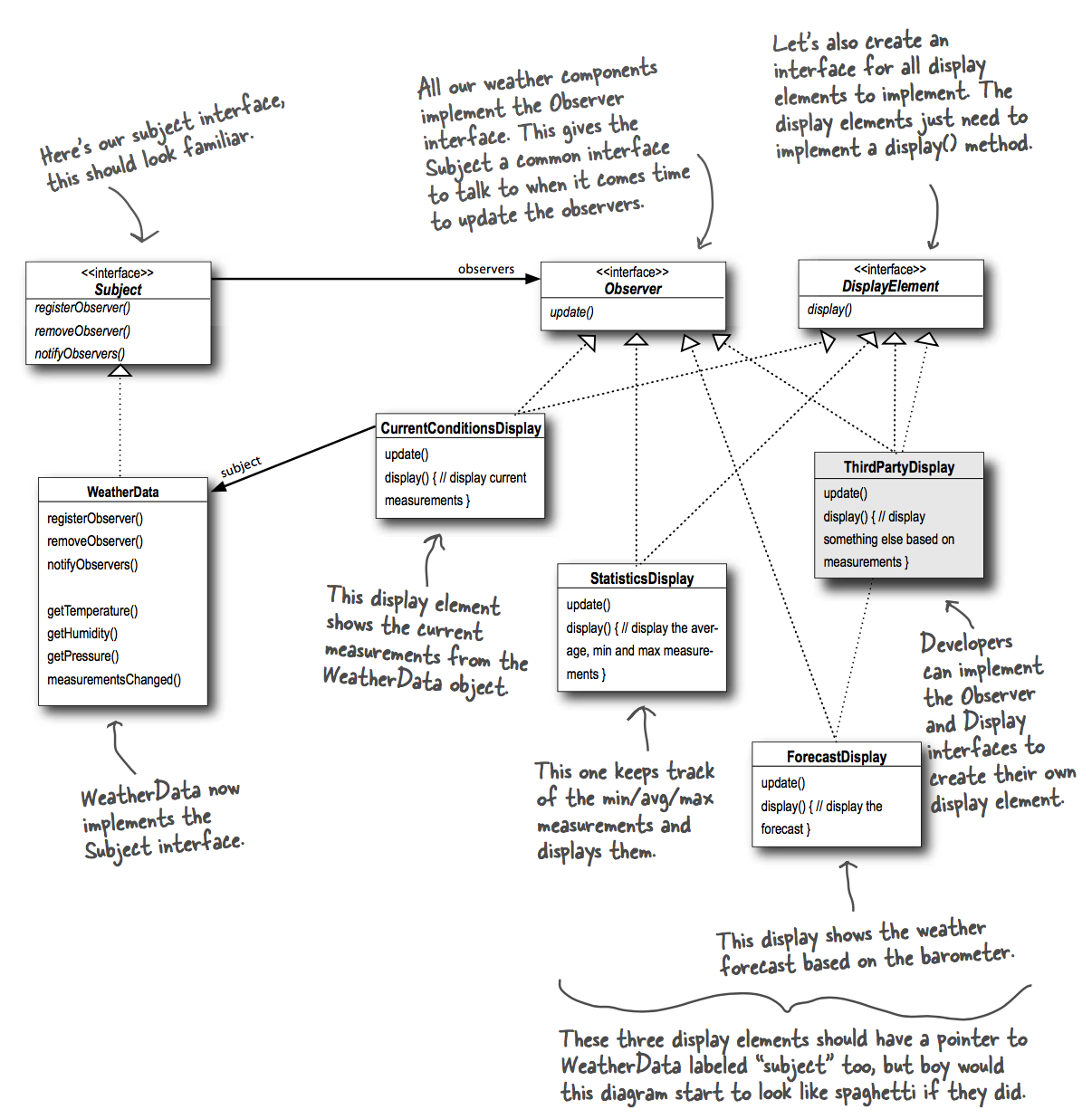
接口
public interface Subject {
void registerObserver(Observer o);
void removeObserver(Observer o);
void notifyObservers();
}
public interface Observer {
void update(float temp, float humidity, float pressure);
}
public interface DisplayElement {
void display();
}
WeatherData 实现 Subject 接口
public class WeatherData implements Subject {
private List<Observer> observers = new ArraryList<>();
private float temperature;
private float humidity;
private float pressure;
@Override
public void registerObserver(Observer o) {
observers.add(o);
}
@Override
public void removeObserver(Observer o) {
int i = observers.indexOf(o);
if (i >= 0) {
observers.remove(o);
}
}
@Override
public void notifyObservers() {
for (Observer o: observers) {
o.update(temperature, humidity, pressure);
}
}
public void measurementsChanged() {
notifyObservers();
}
public void setMeasurements(float temperature, float humidity, float pressure) {
this.temperature = temperature;
this.humidity = humidity;
this.pressure = pressure;
measurementsChanged();
}
// 其他方法略
}
CurrentConditionsDisplay 其中一种Display的实现类
public class CurrentConditionsDisplay implements Observer, DisplayElement {
private float temperature;
private float humidity;
private Subject weatherData; // 这里是重点
public CurrentConditionsDisplay(Subject weatherData) {
this.weatherData = weatherData;
weatherData.registerObserver(this); // 将自己注册到weatherData的列表中
}
public void update(float temperature, float humidity, float pressure) {
this.temperature = temperature;
this.humidity = humidity;
display();
}
public void display() {
System.out.println("Current conditions: " + temperature +
"F degrees and " + humidity + "% humidity");
}
}
测试代码
public class WeatherStation {
public static void main(String[] args) {
WeatherData weatherData = new WeatherData();
CurrentConditionsDisplay currentDisplay = new CurrentConditionsDisplay(weatherData);
StatisticsDisplay statisticsDisplay = new StatisticsDisplay(weatherData);
ForecastDisplay forecastDisplay = new ForecastDisplay(weatherData);
weatherData.setMeasurements(80, 75, 30.4f);
weatherData.setMeasurements(82, 70, 29.2f);
weatherData.setMeasurements(78, 90, 29.2f);
}
}
Java’s build-in Observer Pattern
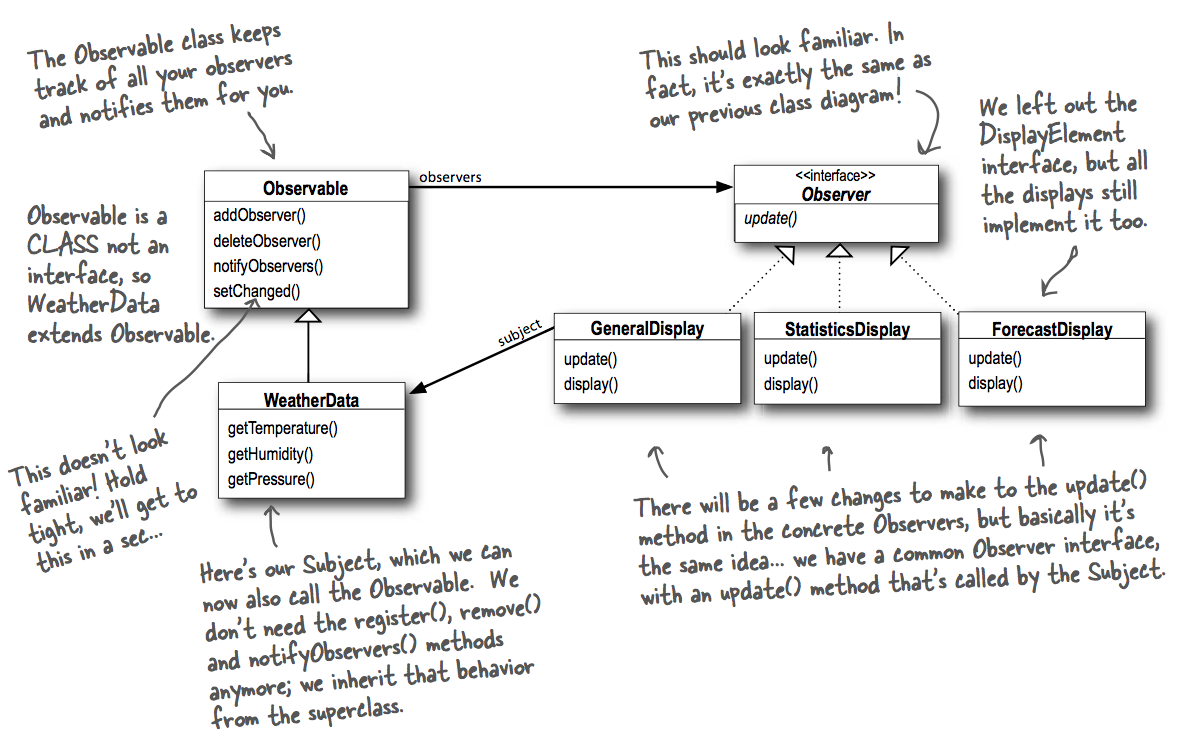
使用java.util.Observable重写WeatherData
import java.util.Observable;
import java.util.Observer;
public class WeatherData extends Observable { // Observable 是类
private float temperature;
private float humidity;
private float pressure;
public void measurementsChanged() {
setChanged(); // 在notifyObservers前调用setChanged()指明状态发生变化
notifyObservers(); // 使用未带参数的notifyObservers()意味着在Observer端进行拉数据(pull model)
}
public void setMeasurements(float temperature, float humidity, float pressure) {
this.temperature = temperature;
this.humidity = humidity;
this.pressure = pressure;
measurementsChanged();
}
// 以下三个方法在之前的写法中略去了,因为现在我们要使用"pull"模式,观察者需要使用这些方法
public float getTemperature() {
return temperature;
}
public float getHumidity() {
return humidity;
}
public float getPressure() {
return pressure;
}
}
使用java.util.Observer重写CurrentConditionsDisplay
import java.util.Observable;
import java.util.Observer;
// 现在我们实现的是 java.util 中的 Observer, 它依然是一个接口
public class CurrentConditionsDisplay implements Observer, DisplayElement {
Observable observable;
private float temperature;
private float humidity;
public CurrentConditionsDisplay(Observable observable) {
this.observable = observable;
observable.addObserver(this);
}
public void update(Observable obs, Object args) {
if (obs instanceof WeatherData) {
WeatherData weatherData = (WeatherData)obs;
this.temperature = weatherData.getTemperature(); // 拉取数据
this.humidity = weatherData.getHumidity();
display();
}
}
public void display() {
System.out.println("Current conditions: " + temperature +
"F degrees and " + humidity + "% humidity");
}
}
观察者模式定义了对象之间一对多的依赖关系,当一对应的对象状态有所变化,所有依赖它的对象都会被通知并自动更新。
🔥 装饰者模式(The Decorator Pattern)
装饰者模式的基本类图结构如下:
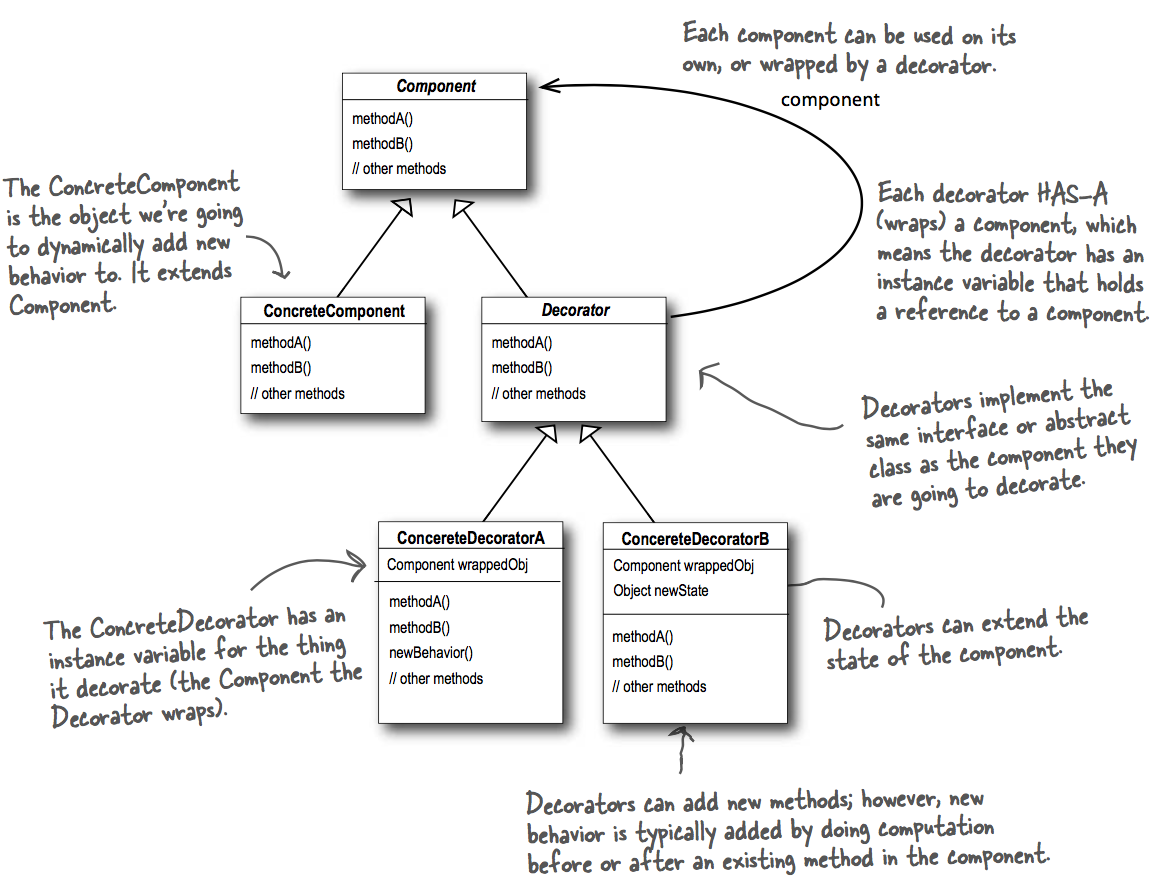
Starbuzz饮品装饰者类图结构如下:
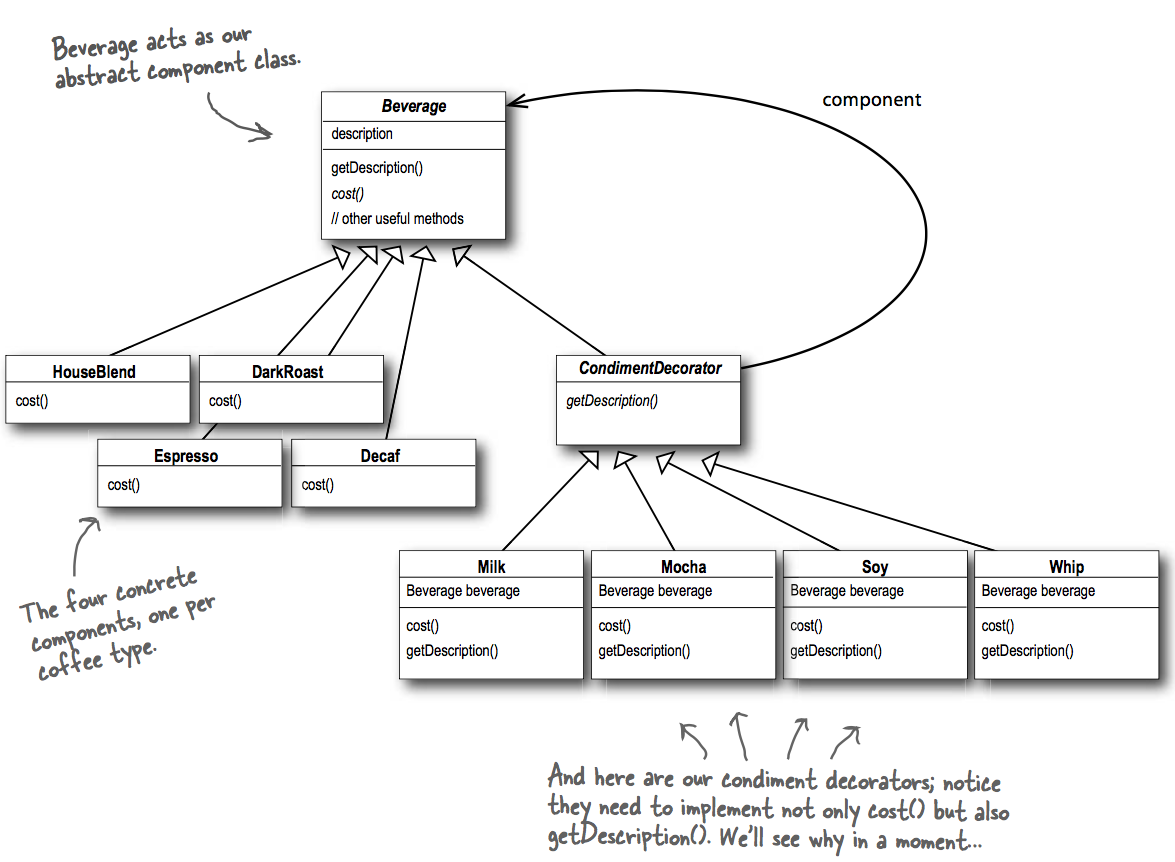
重点: Decorator 使用继承是为了获取类型匹配(type matching),而不是行为(behavior).
Beverage类不需变动
public abstract class Beverage {
String description = "Unknown Beverage";
public String getDescription() {
return description;
}
public abstract double cost();
}
调味品(Decorator)的抽象类
// 调味品可以跟饮品相互替换(Interchangeable),所以继承Beverage
public abstract class CondimentDecorator extends Beverage {
// 所有的调味品都必须重新实现getDescription()方法
public abstract String getDescription();
}
两种饮品的实现
public class Espresso extends Beverage { // 浓咖啡
public Espresso() {
description = "Espresso";
}
public double cost() {
return 1.99;
}
}
public class HouseBlend extends Beverage { // 混合咖啡
public HouseBlend() {
description = "House Blend Coffee";
}
public double cost() {
return .89;
}
}
一种调味品(Decorator)的实现
public class Mocha extends CondimentDecorator { // 摩卡是一个装饰者,所以继承 CondimentDecorator
Beverage beverage; // 对被装饰的类进行包装
public Mocha(Beverage beverage) { // 构造装饰者的时候使用被装饰的类
this.beverage = beverage;
}
public String getDescription() {
return beverage.getDescription + ", Mocha";
}
public double cost() {
return beverage.cost() + .20;
}
}
测试代码
public class StarbuzzCoffee {
public static void main(String args[]) {
// 点一杯浓咖啡,不要任何调味品
Beverage beverage = new Espresso();
System.out.println(beverage.getDescription() + "$" + beverage.cost());
// 点一杯深焙咖啡,加双份摩卡和一份奶油
Beverage beverage2 = new DarkRoast();
beverage2 = new Mocha(beverage2); // 第一份摩卡
beverage2 = new Mocha(beverage2); // 第二份摩卡
beverage2 = new Whip(beverage2); // 一份奶油
System.out.println(beverage2.getDescription() + "$" + beverage2.cost());
}
}
java.io包就是一个装饰者模式的一个实例:
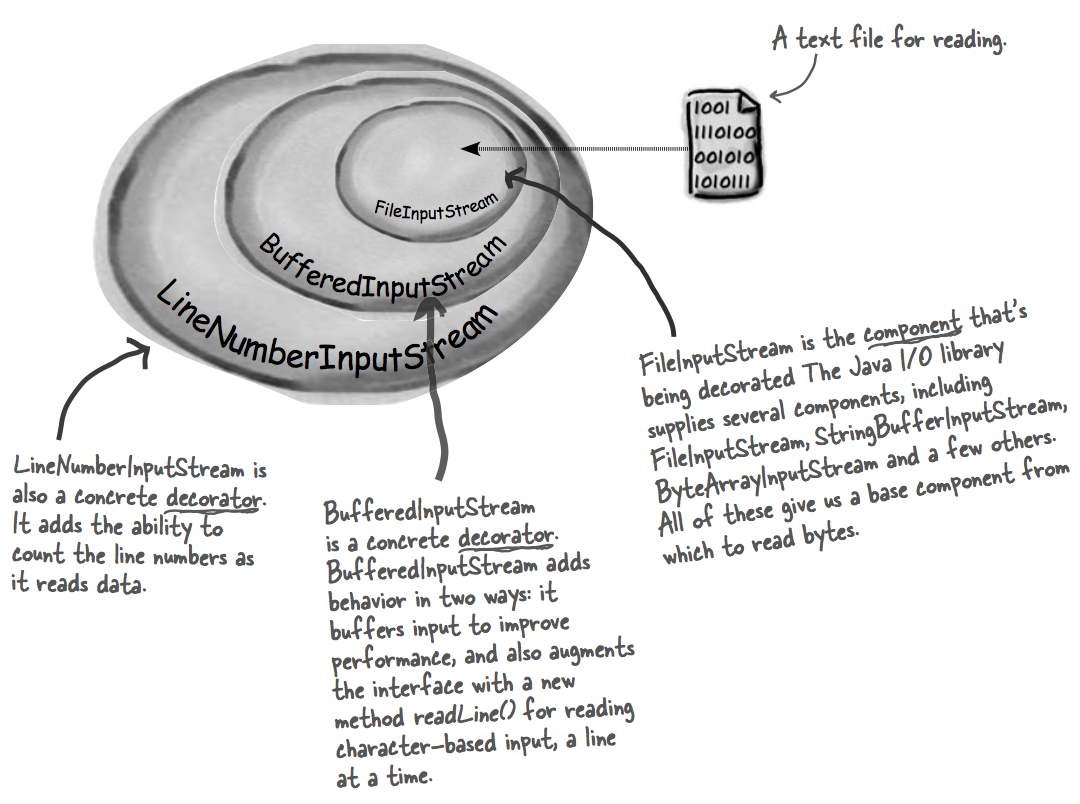
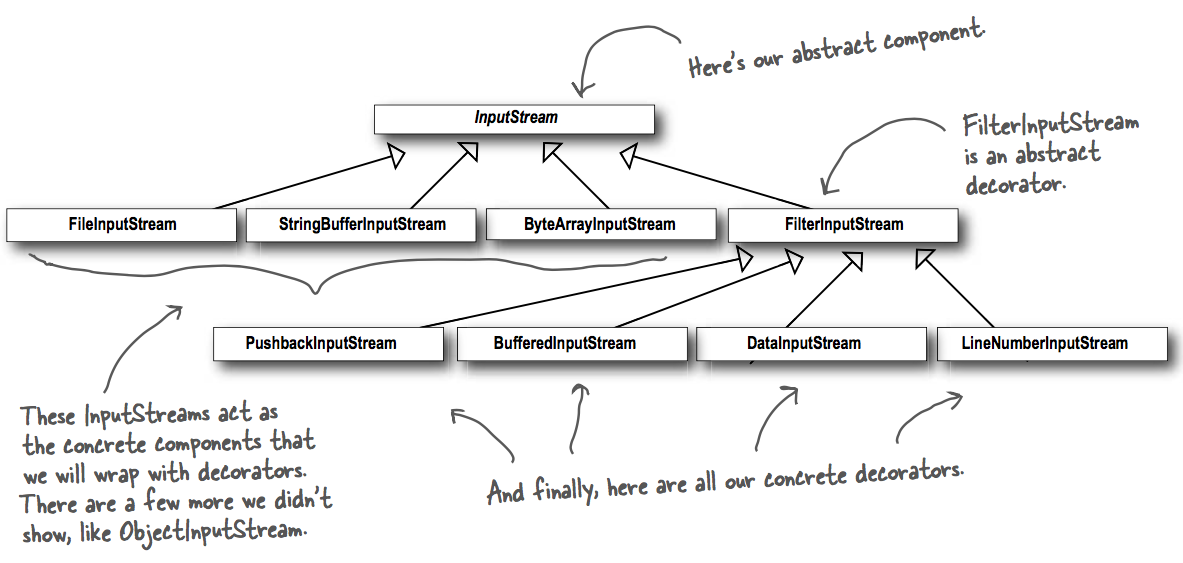
装饰者模式动态地附加一个对象的责任。装饰器提供了用于扩展功能的子类的灵活替换。
🔥 工厂模式(The Factory Pattern)
工厂模式分为简单工厂模式(The Simple Factory)、工厂方法模式(The Factory Method Pattern)和抽象工厂模式(The Abstract Factory Pattern)。
简单工厂模式其实算不上是一种模式,它更像是一种编程习惯(programming idiom)。本文不做介绍。
工厂方法模式(The Factory Method Pattern)定义: 工厂方法模式定义了一个创建对象的接口,并让子类决定实例化对象的类型。工厂方法将实例化推迟得到子类。
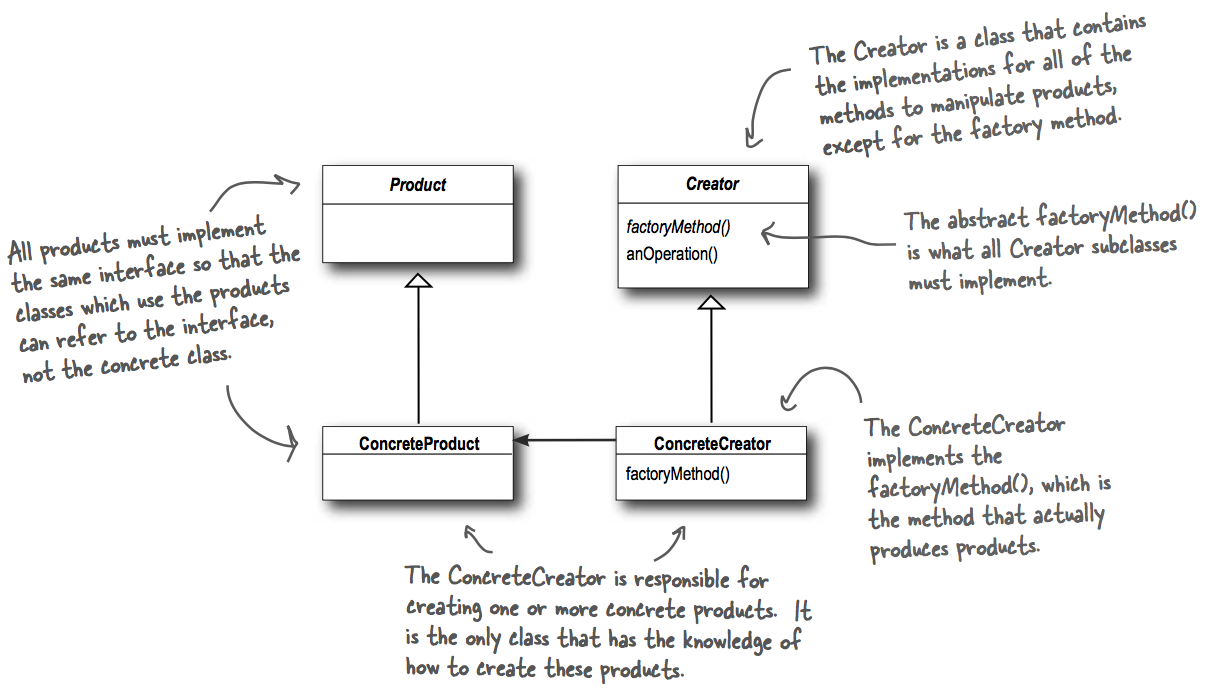
以 PizzaStore 为例:
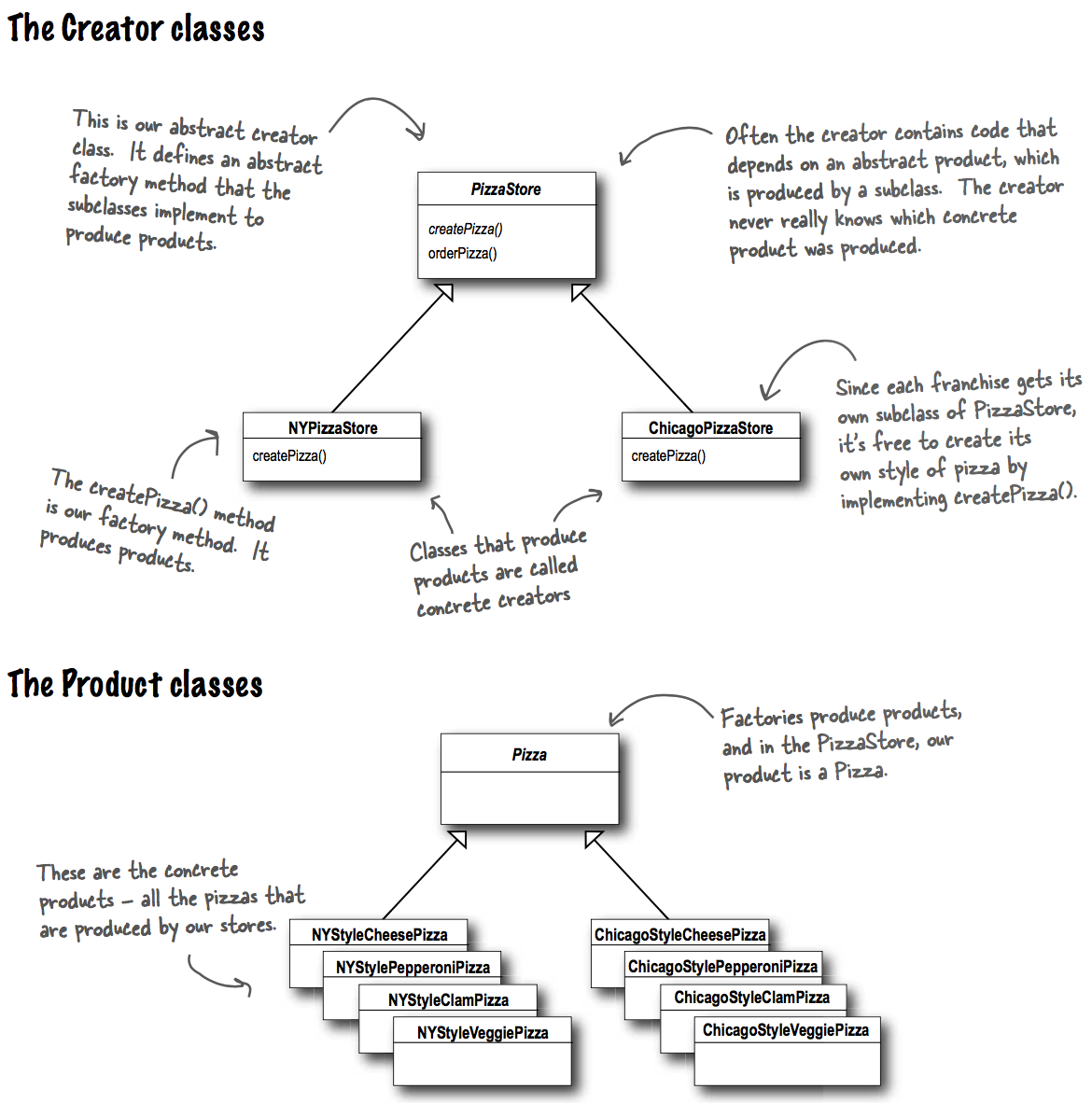
换个视角来看 PizzaStore 类图:
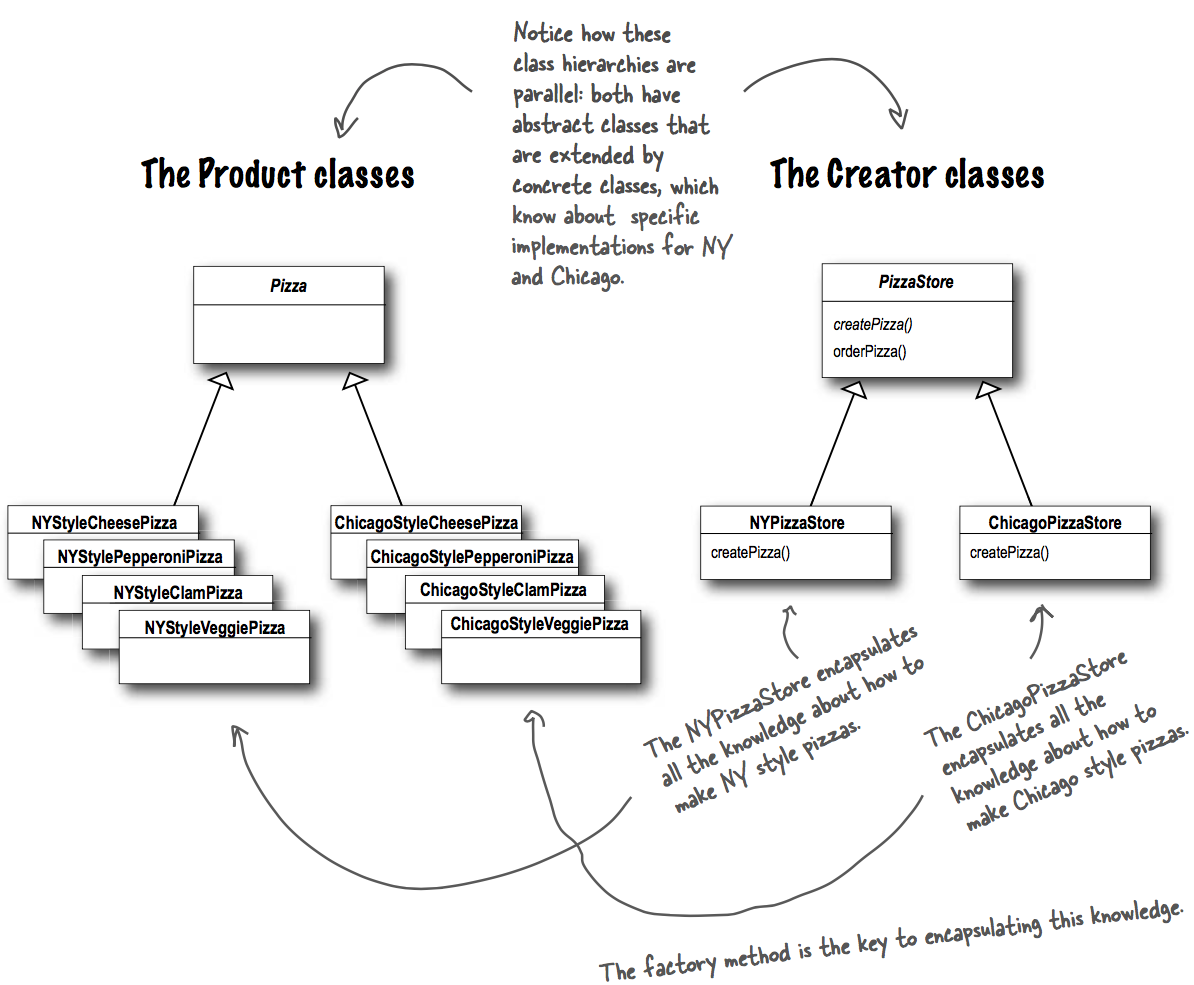
抽象工厂模式(The Abstract Factory Pattern)定义: 抽象工厂模式可以向客户端提供一个接口,使客户端在不必指定具体类的情况下,创建多个相关或独立的对象。
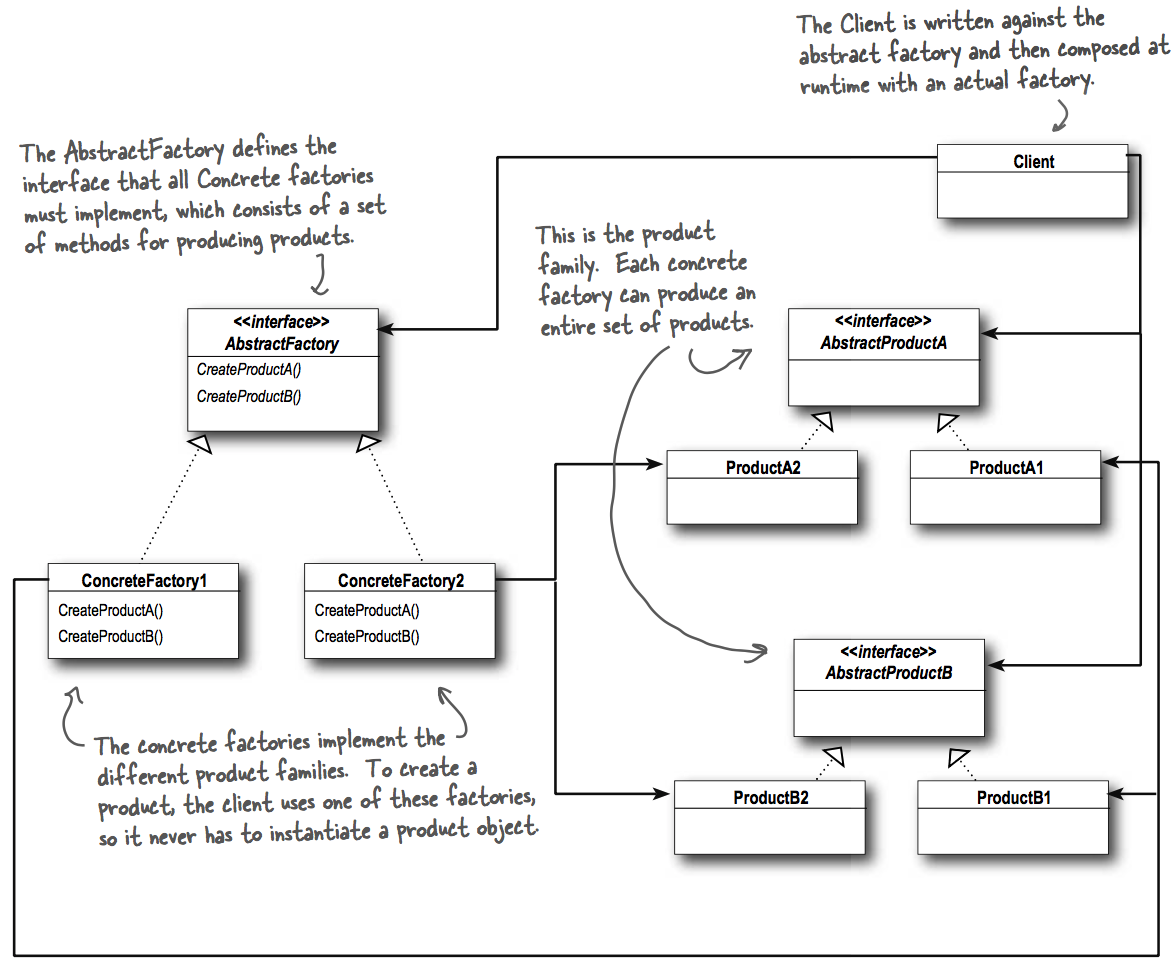
以 PizzaStore 为例:
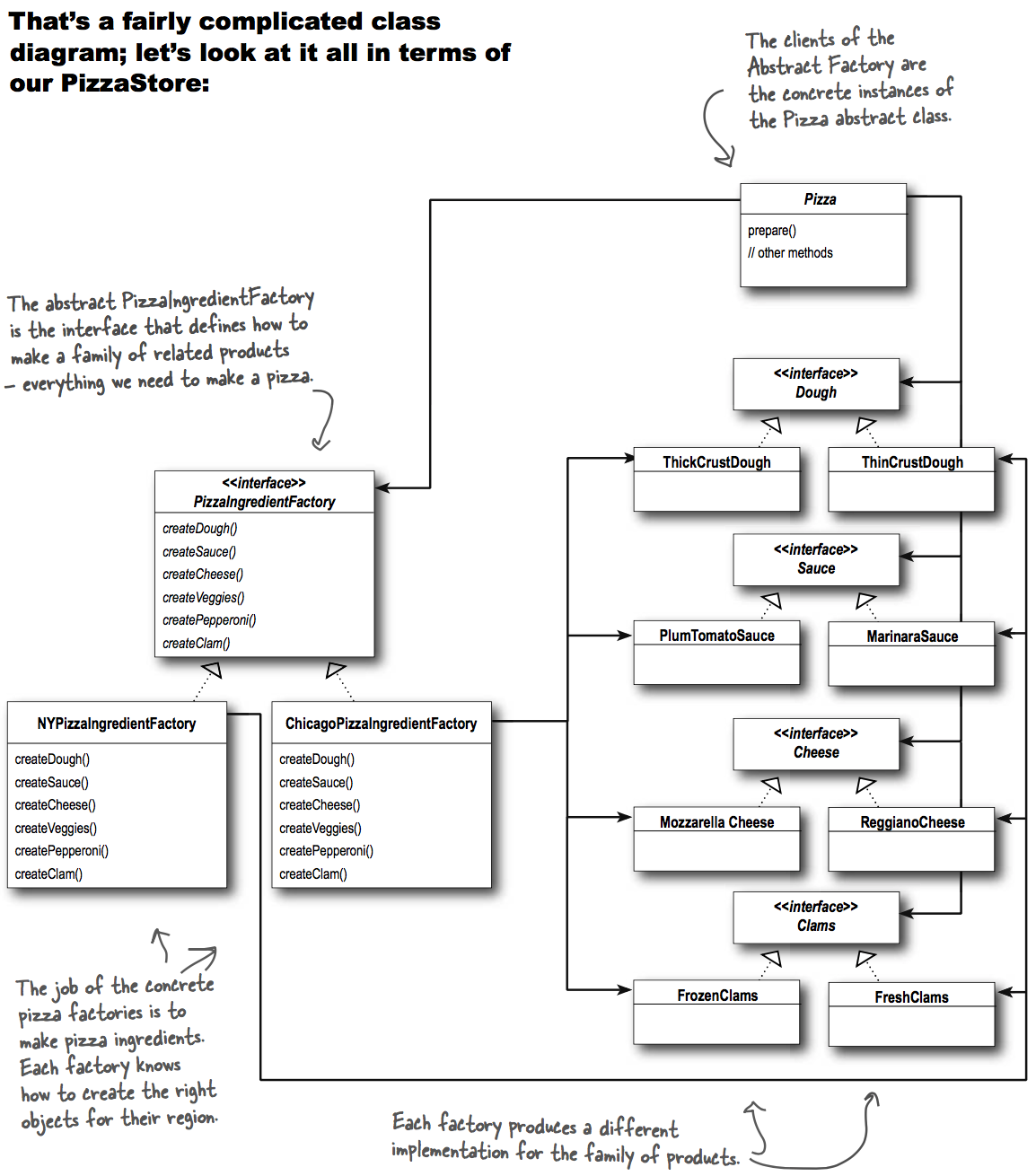
🔥 单例模式(The Singleton Pattern)
单例模式保证了一个类只有一个实例,并提供了一个全局访问点。
public class Singleton {
private static Singleton uniqueInstance;
// other useful instance variables here
private Singleton() {}
public static synchronized Singleton getInstance() { // synchronized 解决多线程可能返回不同对象的问题
if (uniqueInstance == null) {
uniqueInstance = new Singleton();
}
return uniqueInstance;
}
// Other useful methods here
}
但是同步是一种比较重的解决办法,因为当uniqueInstance被赋值以后,synchronized就不再被需要了,因此上面的写法引入了额外的开销。
一种办法是将 Lazily created one 变为 Eagerly created one。这种方法依赖JVM来在装载类的时候创建一个唯一的Singleton实例。JVM保证了实例的创建早于任何线程获取实例。
public class Singleton {
private static Singleton uniqueInstance = new Singleton(); // JVM创建优先于线程访问
private Singleton() {}
public static Singleton getInstance() {
return uniqueInstance;
}
}
另一种办法是使用“double-checked locking”来减少getInstance()中同步的使用。
public class Singleton {
private volatile static Singleton uniqueInstance; // volatile 保证了uniqueInstance在多线程之间的可见性
private Singleton() {}
public static Singleton getInstance() {
if (uniqueInstance == null) { // 保证了同步机制只在第一次实例化的时候被使用
synchronized (Singleton.class) {
if (uniqueInstance == null) {
uniqueInstance = new Singleton();
}
}
}
return uniqueInstance;
}
}
🔥 命令模式(The Command Pattern)
命令模式将请求封装为一个对象,从而允许您用不同的请求、队列或日志请求对其他对象进行参数化,并支持无法执行的操作。
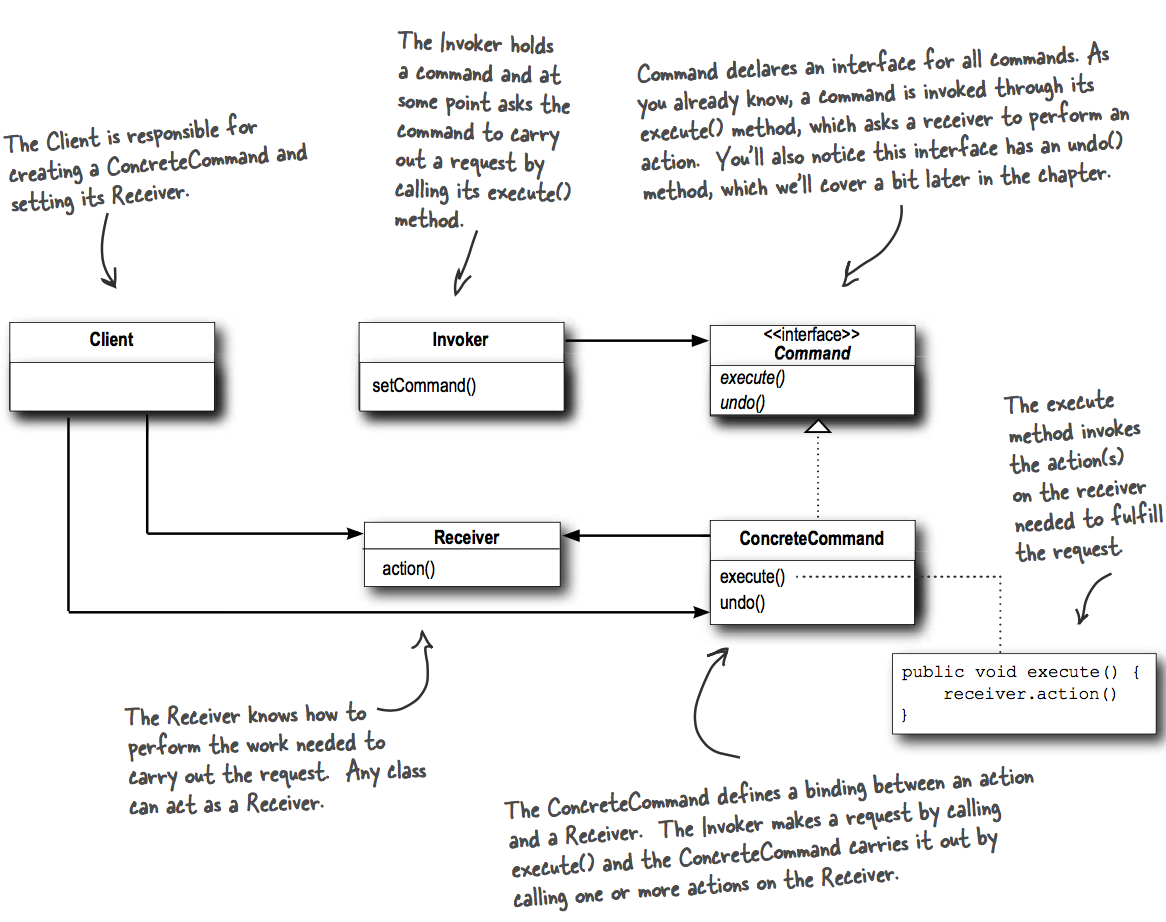
🔥 适配器模式(The Adapter Pattern)
适配器模式将一个类的接口转换为客户端期望的另一个接口。适配器让类协同工作,否则由于接口不兼容而无法正常工作。
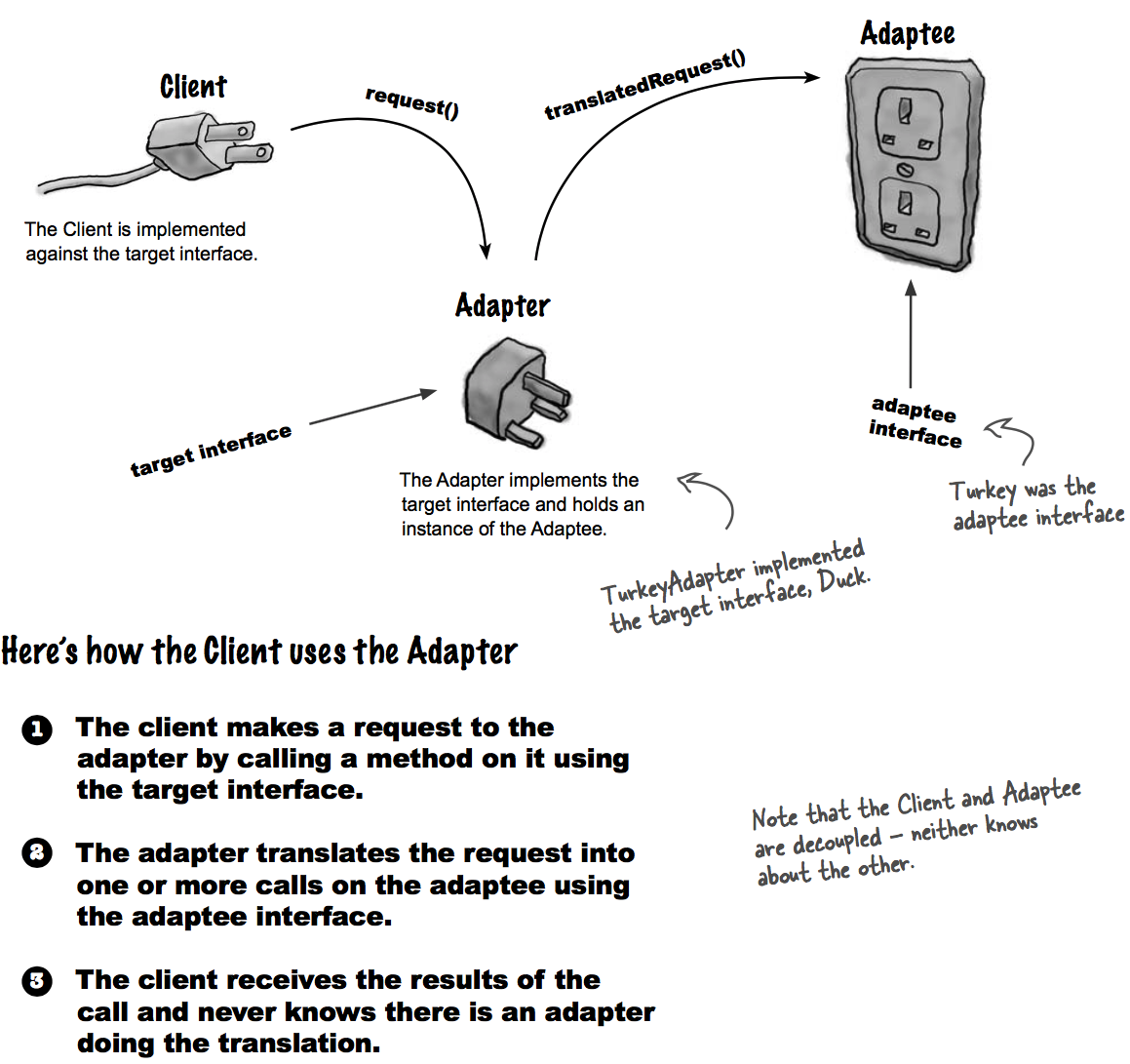
对象适配器(Object Adapter)使用组合(Composition,Adaptee作为Adapter的一部分)来实现。
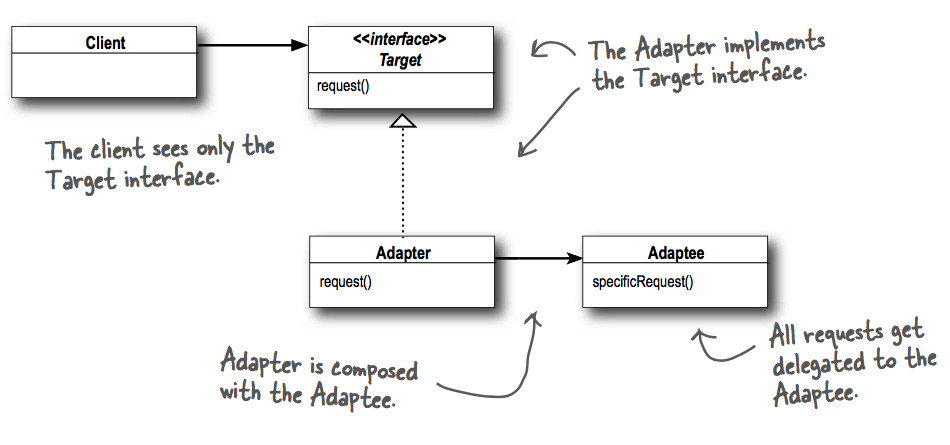
类适配器(Class Adapter)使用多继承(multiple inheritance)来实现,在允许多继承的语言中可以使用。
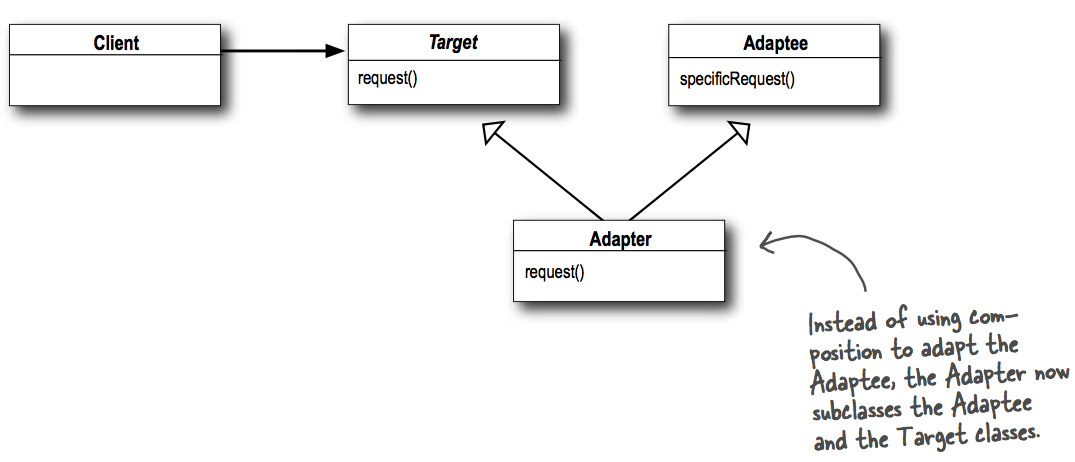
🔥 外观模式(The Facade Pattern)
外观模式为子系统中的一组接口提供统一的接口,它定义了一个高层的接口使得子系统更易于使用。
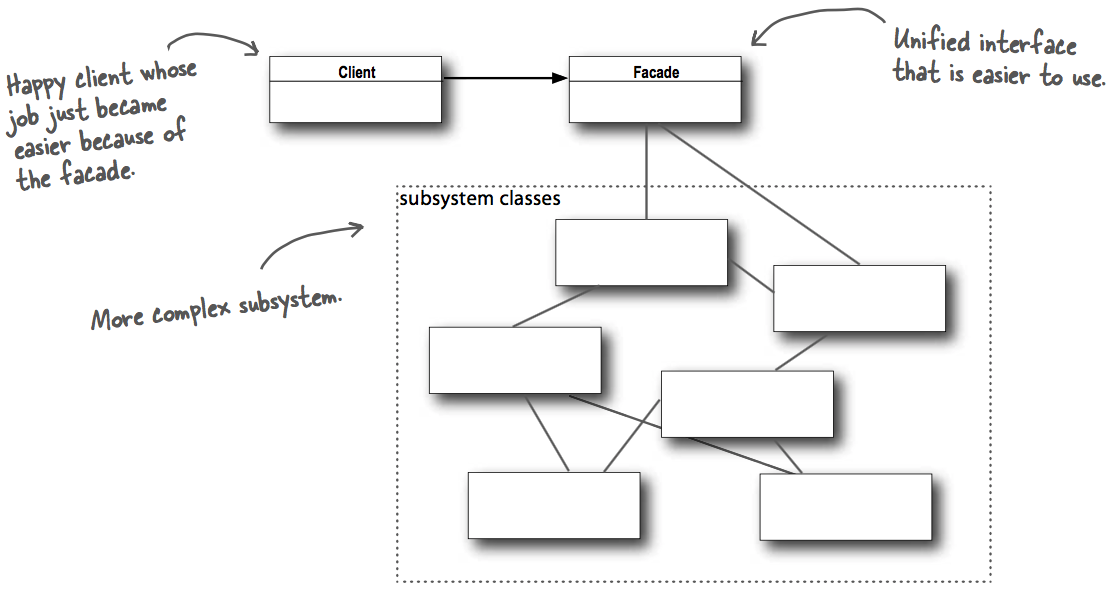
适配器模式和外部模式的不同之处在于:适配器模式的目的是改变接口,使其与客户端期望的接口匹配。 Facade Pattern的目的是为子系统提供一个简化的接口。
适配器封装一个对象来改变它的接口,装饰器包装一个对象来添加新的行为和责任,而外观模式包装一组对象来进行简化。
🔥 模板方法模式(The Template Method Pattern)
模板方法模式定义了方法中算法的框架,将一些步骤推送到子类。模板方法允许子类重新定义算法的某些步骤,而不改变算法的结构。
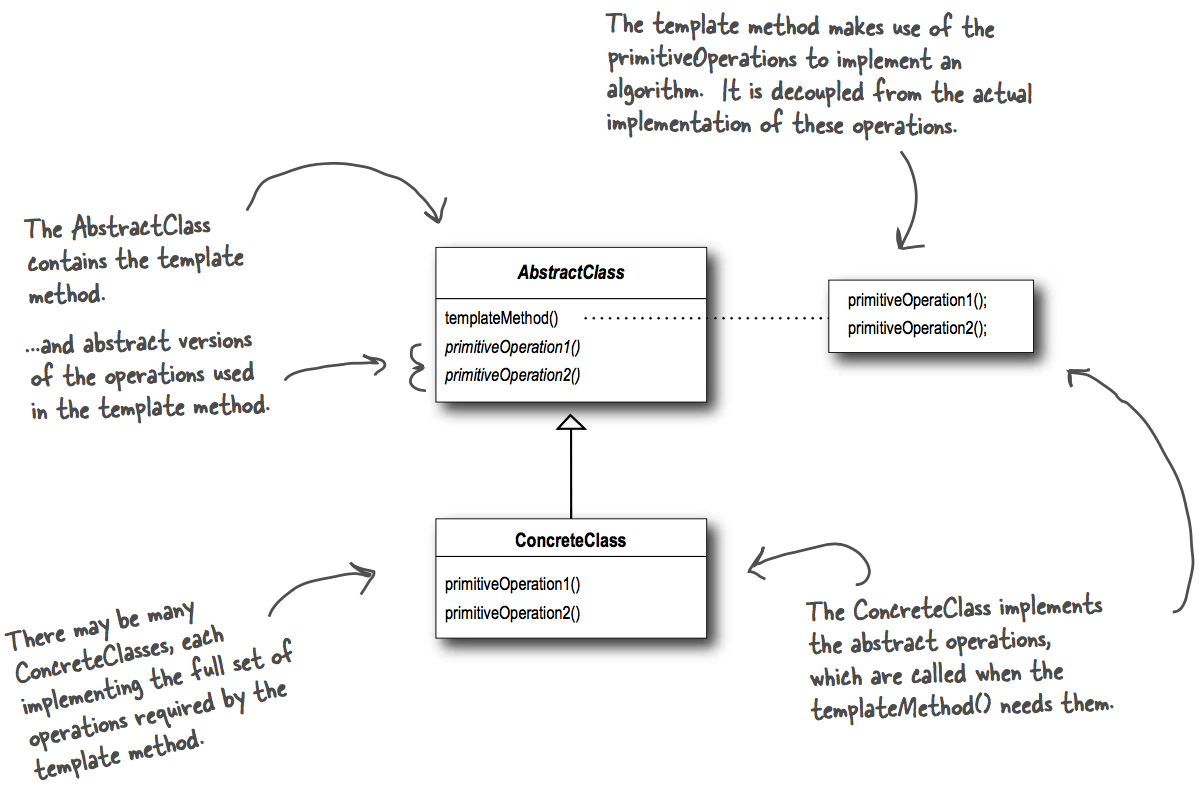
abstract class AbstractClass {
final void templateMethod() {
primitiveOperation1();
primitiveOperation2();
concreteOperation();
}
abstract void primitiveOperation1();
abstract void primitiveOperation2();
void concreteOperation() {
// implementation here
}
}
带钩子(hook)的模板方法模式:
public abstract class CaffeineBeverageWithHook {
final void prepareRecipe() {
boilWater();
brew();
pourInCup();
if (customerWantsCondiments()) {
addCondiments();
}
}
abstract void brew();
abstract void addCondiments();
void boilWater() {
System.out.println("Boiling water");
}
void pourInCup() {
System.out.println("Pouring into cup");
}
boolean customerWantsCondiments() { // 子类可以Override该方法,但不是必须的
return true;
}
}
当子类必须提供算法中的方法或步骤的实现时,使用抽象方法。当算法的那部分是可选的时候使用钩子。使用钩子,一个子类可以选择实现该钩子,但它不是必须的。
🔥 迭代器模式(The Iterator Pattern)
迭代器模式提供了一种顺序访问聚合对象元素的方法,而无需公开其底层表示。
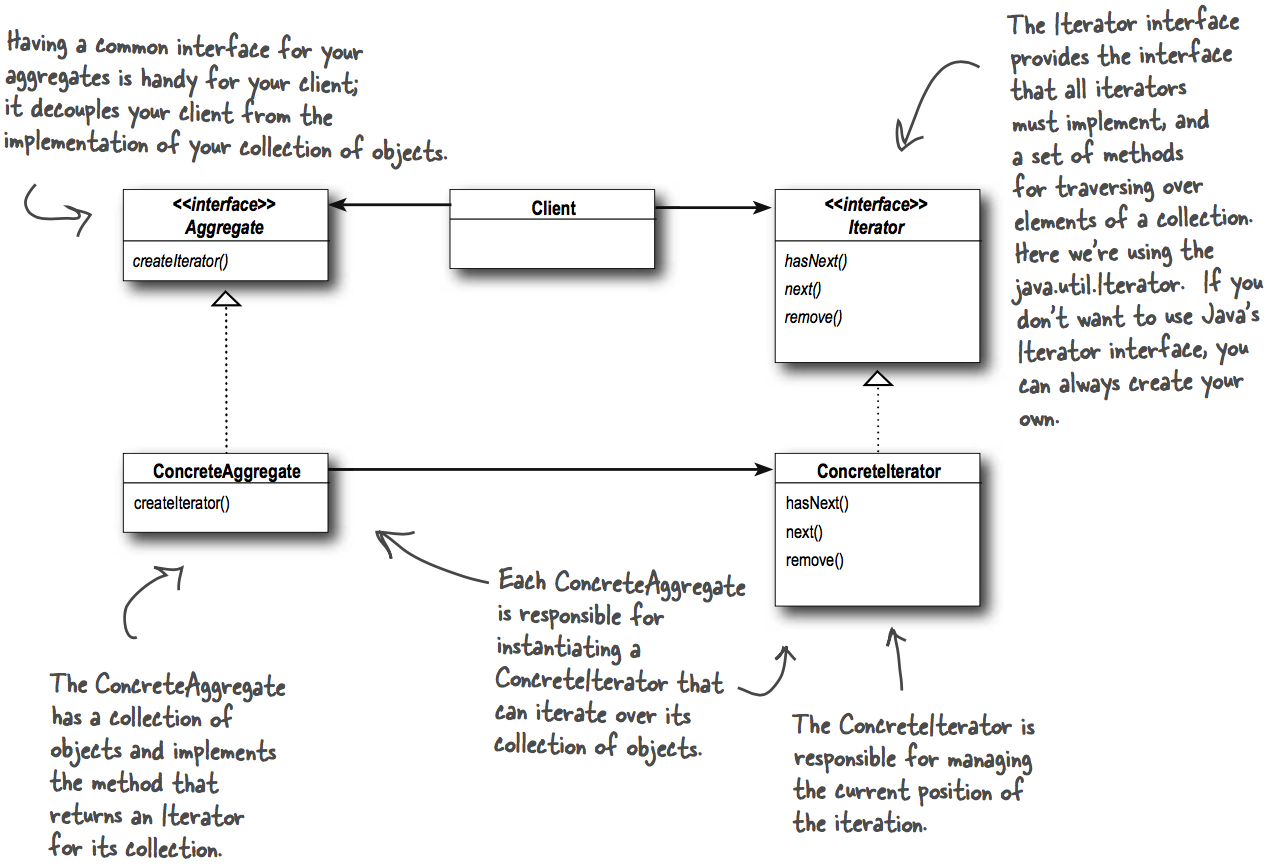
🔥 组合模式(The Composite Pattern)
组合模式允许你将对象组合到树结构中,以表示部分-整体层次结构。组合允许客户对对象和对象的组合进行一致的处理。
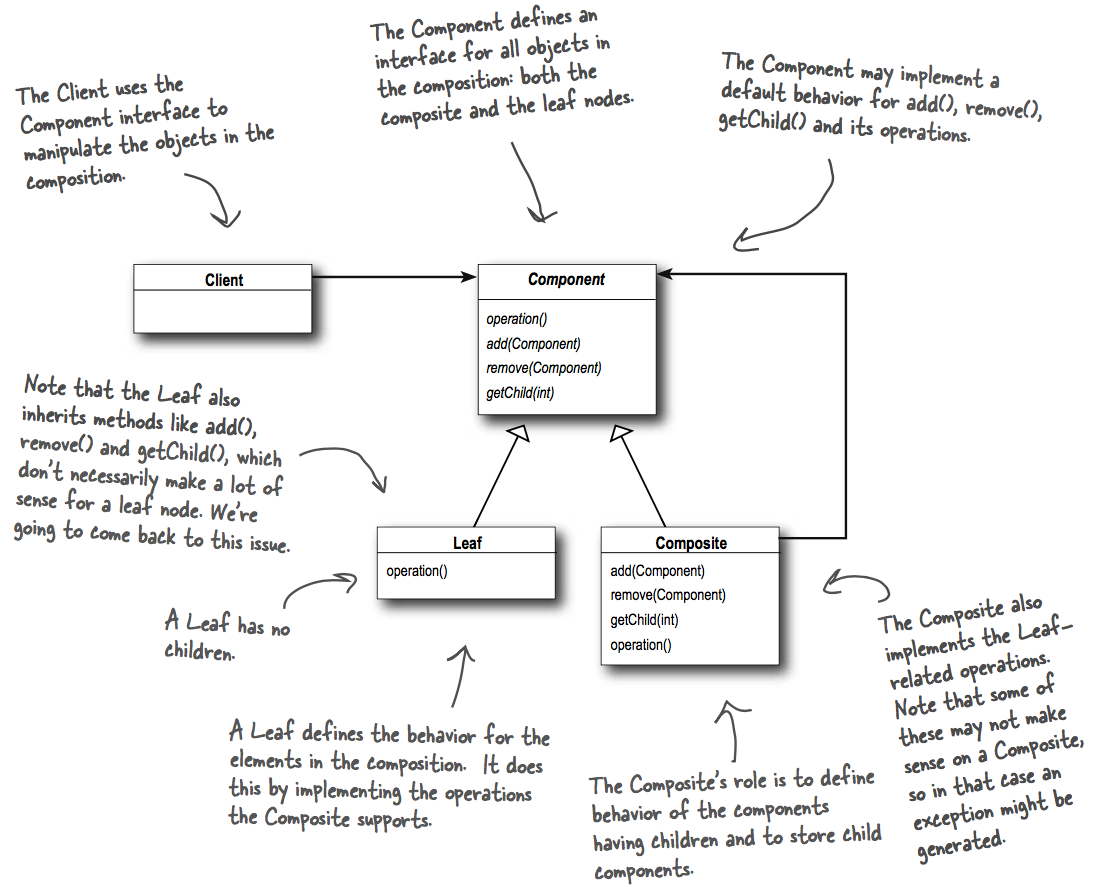
🔥 状态模式(The State Pattern)
状态模式允许对象在内部状态更改时更改其行为。对象会改变它的类。
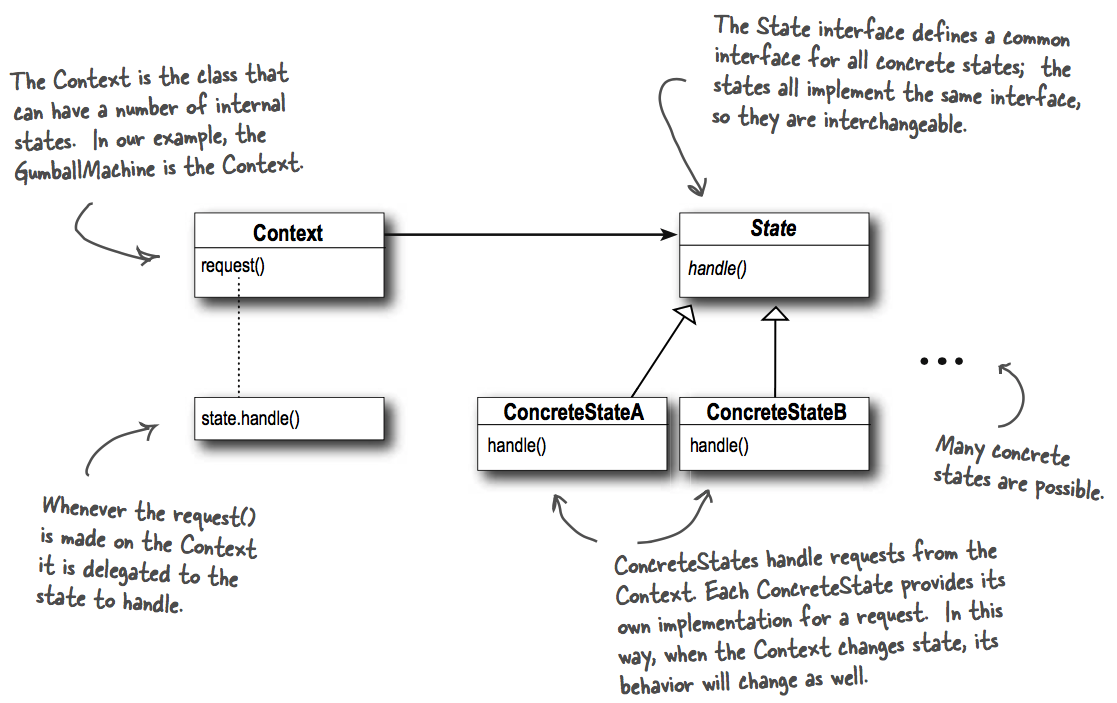
🔥 代理模式(The Proxy Pattern)
代理模式为另一个对象提供代理或占位符来控制对它的访问。值得注意的是,在实际实践中,代理模式会衍生很多变种,如:
- Remote Proxy(RMI)
- Virtual Proxy
- Firewall Proxy
- Smart Reference Proxy
- Caching Proxy
- Synchronization Proxy
- Complexity Hiding Proxy
- Copy-On-Write Proxy
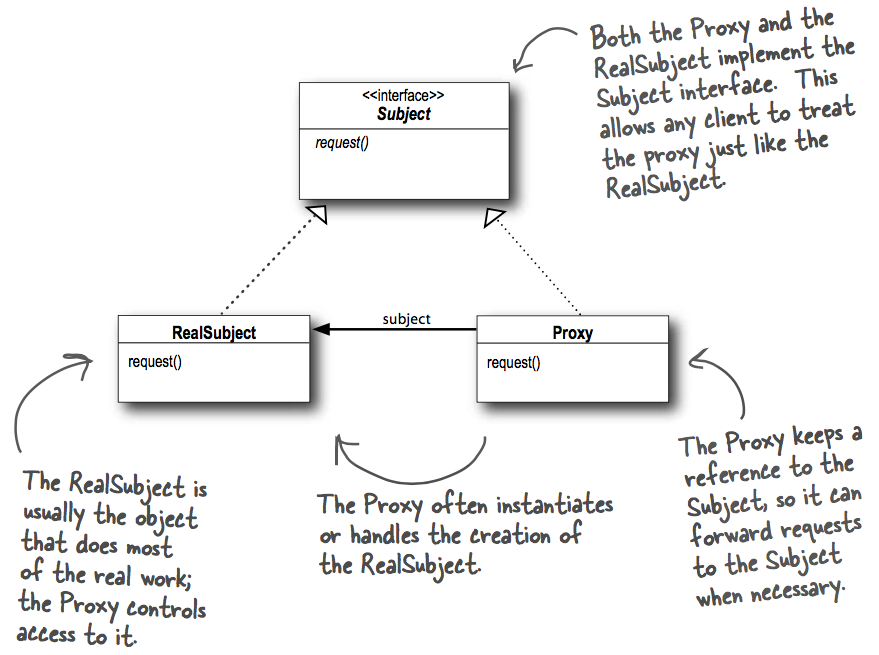
Model-View-Controller

MVC是一种组合模式,即将多种设计模式一起使用来解决一类通用的问题。从设计模式的角度看MVC模式:
